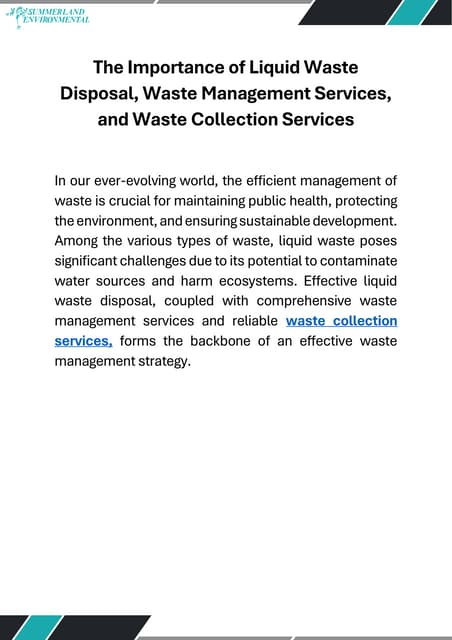The Buzz on Reclaim Waste
The Buzz on Reclaim Waste
Blog Article
Some Known Incorrect Statements About Reclaim Waste
Table of ContentsThe Buzz on Reclaim WasteNot known Incorrect Statements About Reclaim Waste The Ultimate Guide To Reclaim WasteThe Definitive Guide to Reclaim WasteHow Reclaim Waste can Save You Time, Stress, and Money.Reclaim Waste Can Be Fun For Anyone

Never ever put hazardous materials down sinks, bathrooms or stormwater drains pipes Compounds including petrol, oil, oil, pesticides and herbicides, and solvents such as paint pole dancers ought to not be put down sinks, commodes or stormwater drains. These compounds are hard to eliminate in the sewer treatment process and trigger pollution troubles in our neighborhood waterways.

Although fluid waste is a term that covers a broad range of products, there's a good reason why leaving its disposal to the specialists is recommended. Fluid waste is non-solid material that has no additional use and has to be dealt with and disposed of according to regional, state and federal policies.
Not known Details About Reclaim Waste
Although instances of liquid waste can include wastewater, fats, oils or grease, used oil, liquids, solids, gases or sludges and dangerous home liquids, there are some that are thought about to be a lot more harmful than others when it comes to the setting and the health of pets and human beings alike. It's because of this that each state and territory have actually rigorous laws connected to fluid waste monitoring.
Fluid waste can be saved in holding tanks or packaged in drums, intermediate bulk containers or authorized tiny containers before either being dealt with or gotten rid of via outsourced vacuum cleaner trucks. Offered the nature of the materials, liquid waste can not enter the basic waste stream and there are rigorous laws on how to take care of it correctly.
(https://www.slideshare.net/leonaube33101)Depending upon a decision of the level of danger, it may be required to remediate those websites. Furthermore, unsafe fluid chemical wastes are controlled waste and must be tracked according to the state waste legislation. Under the chain of protection and obligations, proprietors are accountable and liable for waste produced by a company.
Among the core applications for superabsorbent polymers (SAPs) is liquid waste solidification. industrial wastewater treatment. SAPs are used by waste management specialists to avoid potentially unsafe fluids from entering waterways, groundwater aquifers, and other sensitive environments. Because liquids can swiftly transport pollutants into ecological receptors and possibly add to geotechnical failings, liquid wastes are practically constantly prohibited from disposal in land fills
Reclaim Waste for Beginners
Primarily, free fluids are fluids that separate from the solid part of waste product. Fluid waste can include the following: HDD mud and cuttings Land fill leachate Wastewater therapy sludge & biosolids Dug up debris Oil and gas drill cuttings Settling pond filth Hydro Excavation slurry Coal combustion residuals/ash Tank bottom sludge Concrete grinding/polishing slurry Relevant Short article: For a sensible instance of free liquids dividing from waste product, consider the following scenario: A waste administration professional lots a dump associate sludge from a wastewater treatment plant's oygenation basin, during a routine maintenance event.
Nonetheless, when the motorist gets to the garbage dump, he notifications water seeping from the sludge and pouring from the dump truck. The load was denied by the land fill and the vehicle driver was required to deal with the waste as a liquid waste at a special center, which boosted the disposal charges significantly.
The globe is sinking in rubbish and we can't manage to be reckless anymore. We need to take action and reuse whatever we can anywhere we can. We likewise require to be accountable for the correct disposal of our waste products. It is inadequate that we pay waste disposal firms to look after our rubbish.
Reclaim Waste - Questions

Segregating your waste can start inside the home. Set apart dry and liquid waste as well as edible waste, eco-friendly and non-biodegradable products.
Layer the base with dirt to soak up the damp waste. Layer the compost with wet and dry waste as well as soil to preserve an equilibrium in between the damp and the dry.
The Basic Principles Of Reclaim Waste
To help with faster decay, you can also include semi composted dirt to the compost. If you notice the smell is becoming also strong, add additional newspapers and paper waste or include even more holes to the compost bin to keep the balance of the waste materials.
We additionally require to be liable for the correct disposal of our waste materials. It is not sufficient that we pay waste disposal companies to take treatment of our rubbish.
Our waste, our duty. Have you additional hints ever questioned what occurs to your liquid waste after it's accumulated? Did you know that fluid waste can be recycled? As liable residents, you should recognize what happens to your rubbish and where it pursues it is taken away from you. Comprehending the fluid waste elimination process is necessary in aiding you to segregate your waste.
8 Simple Techniques For Reclaim Waste
Segregating your waste can begin inside the home. Set apart dry and fluid waste as well as edible waste, eco-friendly and non-biodegradable products.
You can use old garbage can, pail, garden pot or old plastic drums. Drill four to 5 openings in the container so the air can flow. Layer the base with dirt to take in the wet waste. Start the composting procedure. Layer the garden compost with damp and dry waste as well as soil to keep an equilibrium in between the wet and the dry.
To help with faster disintegration, you can likewise include semi composted soil to the compost. If you see the odor is ending up being too solid, add added newspapers and paper waste or include more openings to the compost container to keep the equilibrium of the waste materials.
Report this page